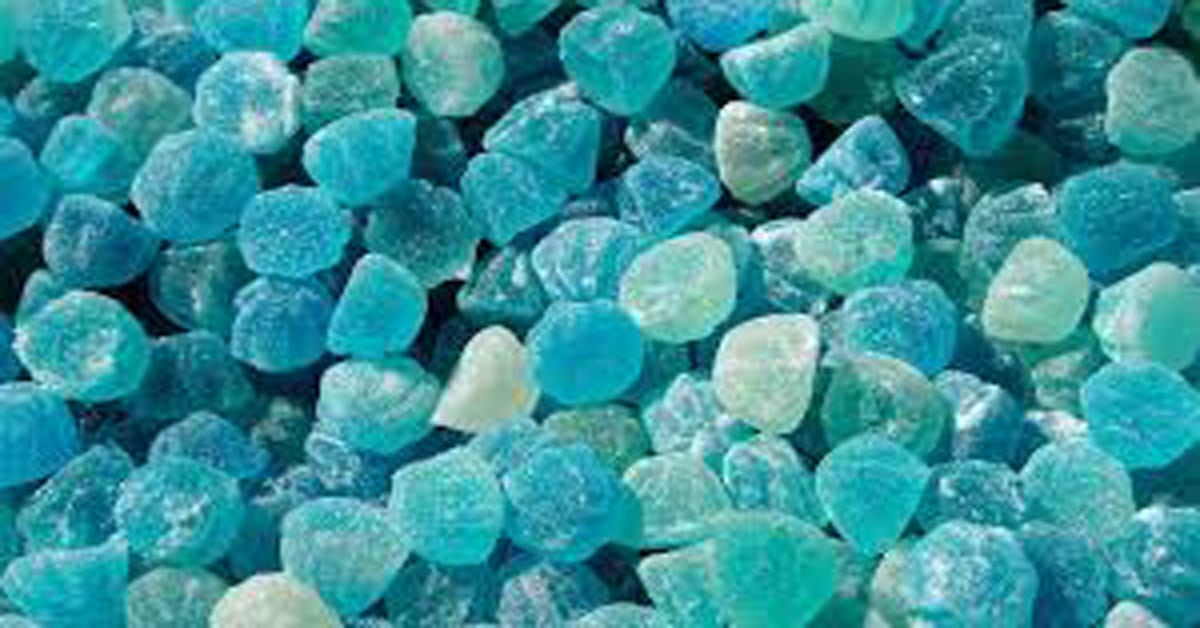Blue Candy – Colorful Overview Of Delectable Sweets
Did you know that blue consistently ranks as the most popular hue worldwide? That’s great news since there are so many oceans with blue colors and a vast blue sky above us. If you are obsessed with the color blue, then the good news is that there are a wide range of choices when it comes to blue candy. From pale to dark blue, blue candy comes in a variety of forms and sizes.
Below, we will explore the amazing and delicious world of blue candy. Let’s dive into this sweet adventure.
Please leave a review or any memories of this snack in the comments at the bottom of this page. Thank you!
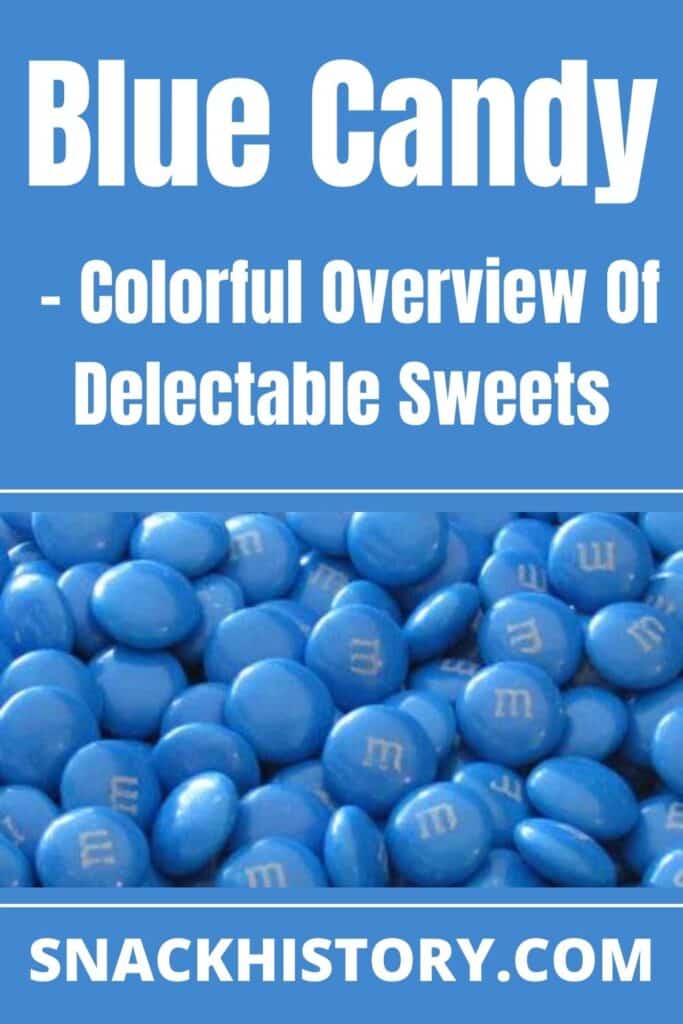
Blue Raspberry Flavor
So, how did blue candy get its popularity? When food flavoring first appeared in the 1950s, it was a thriving industry. It made the hues of artificial components more vibrant, particularly appealing to young eyes. It was established with ice cream trucks, fair refreshment booths, and amusement park concession stalls, among other eating places.
Artificial blue raspberry flavoring and coloring are used in soft beverages, syrups, sweets, and blue candy items. There are no raspberry species from which the taste or hue is derived. The taste characteristic of raspberry was created using “mostly esters of the banana, cherry, and pineapple types,” according to Jerry Bowman, executive director of the Flavor & Extract Manufacturers Association of the United States as of 2016. To make blue raspberry essence more appealing to the palate, sugar is frequently used.
The vivid blue synthetic food coloring Brilliant Blue FCF (also known as Blue #1), which has the European food coloring code E133, is frequently used to color food items that are marked as having a blue raspberry taste.
The blue raspberry is said to have originated in the middle of the 20th century. The product was developed in 1958 by the Cincinnati Culinary Company in an effort to promote raspberry. As is well known, the berry is almost always crimson in the wild. It would stand out from the crowd if you gave it a blue makeover.
Foods with raspberry flavors were distinguished from those with cherry, watermelon, and strawberry flavors, which are all red, by using the color blue. In order to spice up snow cones and blue candy, raspberry taste, and hue were first used in the United States in 1958.
Out of concern for the safety of consumers, regulatory organizations like the US Food and Drug Administration give producers guidance on fake tastes and colors, and they have authorized the use of blue raspberry as a safe component since 1969.
Surprisingly, there is a blue raspberry-like plant found in nature. The shrub, also known as the whitebark raspberry, can be found in North America west of the mountains, from Alaska to Mexico. However, it’s a comparatively uncommon variety that yields berries that can occasionally be blue, occasionally purple, or somewhere in between. The idea of the blue raspberry was created to pique interest and spark creativity. It is now commonplace, particularly in the sweet sector, as already mentioned above.
Regardless of your opinions on the taste, blue raspberry is unquestionably enjoyable. Since its first significant breakthrough in the early 1970s, it has been remarkably constant and has never really let up.
5 Popular Blue Candy Brands
1. Blue Raspberry Airheads
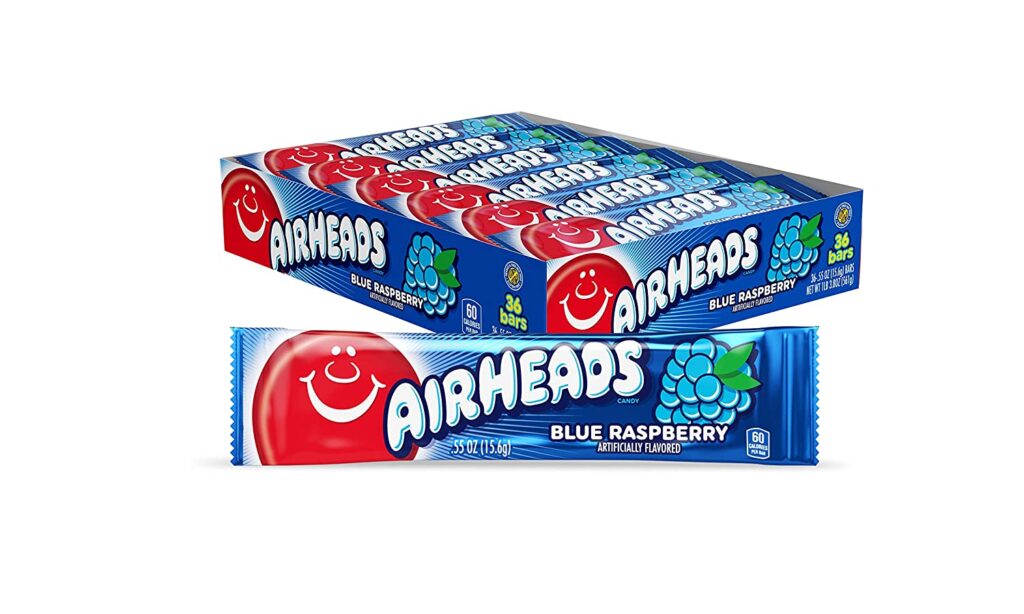
Blue Raspberry Airheads was first introduced in 1986 by the American candy company, Perfetti Van Melle. The blue raspberry flavor was created as a way to expand the Airheads product line and appeal to consumers who enjoy fruity and tangy flavors. Today, Blue Raspberry Airheads are still a popular blue candy among children and adults alike.
Blue Raspberry Airheads is produced by Perfetti Van Melle, a Dutch-Italian business. Although they are produced in Kentucky, these sweets are available across the US. They come in a variety of varieties and are chewy and piquant. These sweets have a taffy structure that is less tough to swallow than many other taffies, which makes for an overall much more pleasurable consuming experience.
In 1985, this confection was first produced. There are currently over 16 varieties available, and they are distributed in both Canada and the US.
The candy was initially created in connection with a product that the Perfetti business was manufacturing in Germany. This product came packaged in two sections of rice paper and was a squishy fruit chew. While they were working to create Fruit Wrinkles, Lipton Tea decided to market this candy. The businesses decided to produce both sweets and gauge consumer preference. The Airheads have released blue candy over the years. Some examples are blue raspberry and blue raspberry cherry.
2. Blue Sour Patch Kids
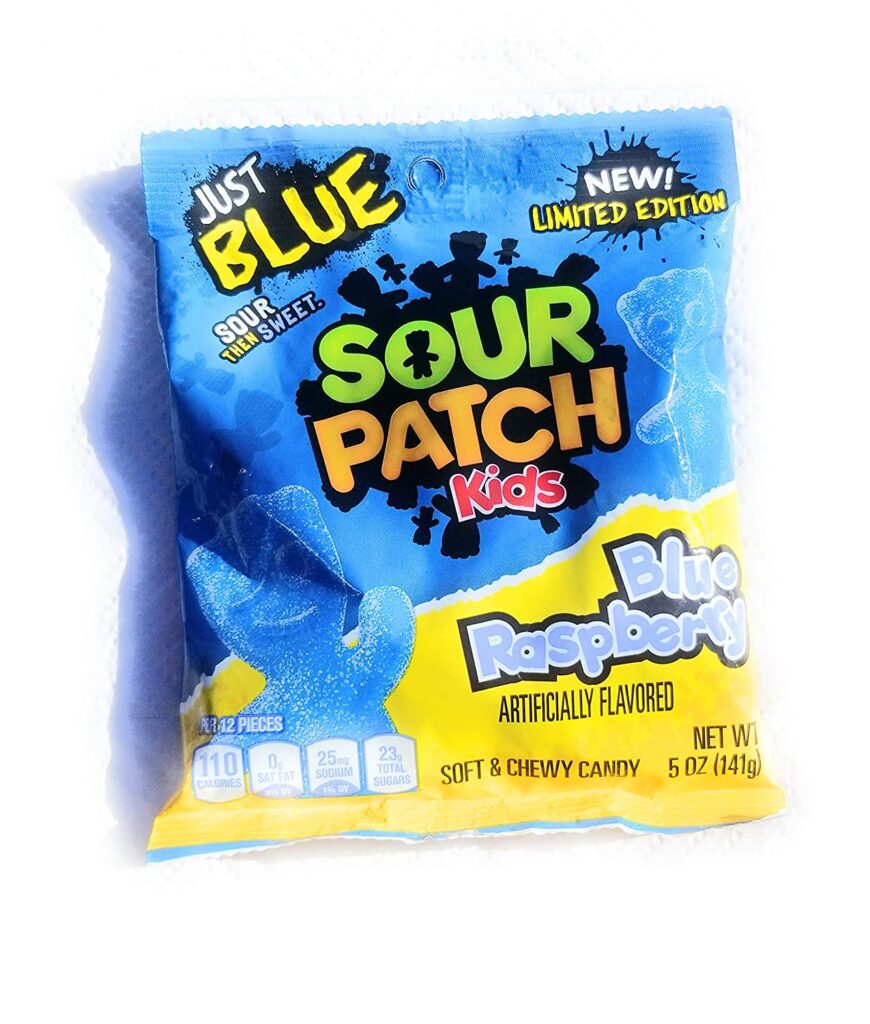
Blue Sour Patch Kids were introduced in the mid-2000s by the American candy company Cadbury Adams and is a popular blue candy. The addition of a blue raspberry flavor to the Sour Patch Kids product line was likely a response to the popularity of blue raspberry flavors in other candies and beverages.
Blue Sour Patch Kids are often sold in multi-flavor packs or as a standalone flavor.
Sour Patch Kids are a type of soft, chewy candy that comes in a variety of fruit flavors and is coated in sour sugar. They take the shape of the Sour Patch Kids or other diminutive humanoids. This confection is covered in a coating that resembles sour sugar and is available in a range of hues and tastes.
Both for their appearance and flavor, Sour Patch Kids have gained popularity and have a sizable following. When it was first developed in the 1970s, Sour Patch Kids was originally known as “Mars Men,” but in 1985, the name was changed to “Sour Patch Kids.”
The soft confection known as Sour Patch Kids, also referred to as Very Bad Kids in France and Maynards Sour Patch Kids in the UK and Canada, has an inverted sugar and sour sugar coating that gives it an acidic and sweet flavor.
3. Blue Jelly Belly Jelly Beans
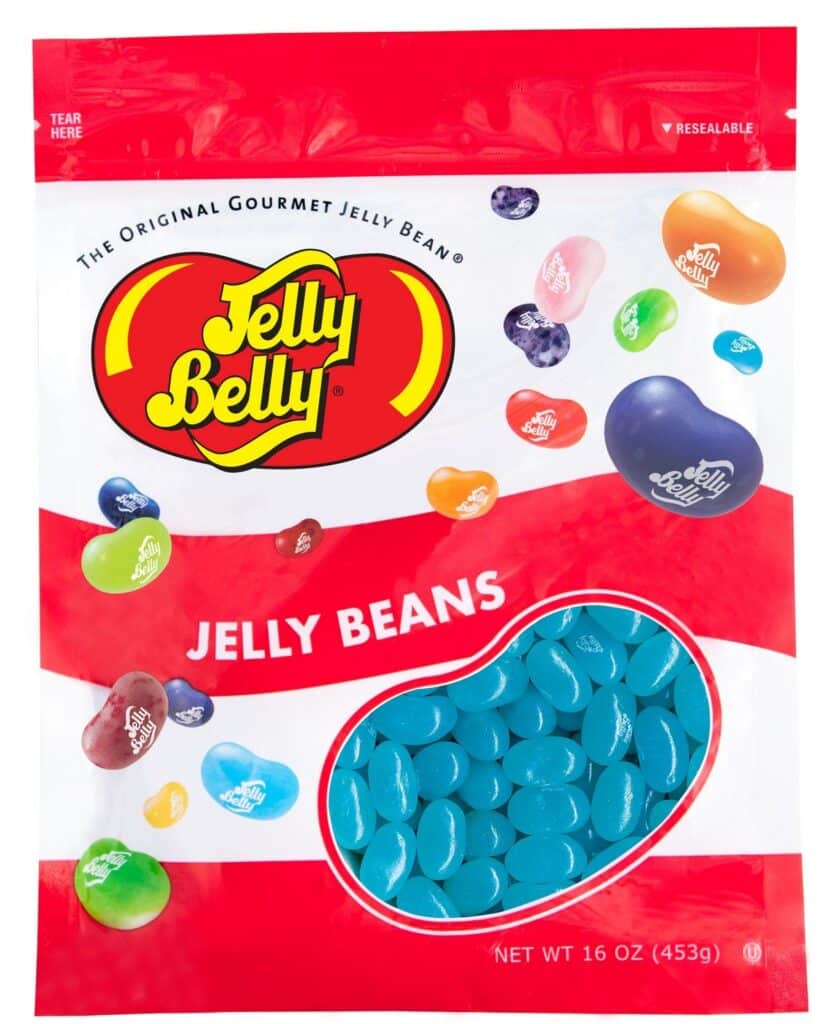
Some of the most popular blue candy is Jelly Belly jelly beans, such as Berry Blue and Blueberry, which have blue as their distinctive hue. Berry Blue has a pale blue color that resembles a perfectly transparent sky. Berry Blue beans, which are a part of our lineup of Jelly Belly Original Varieties, continue to be a top seller. Blueberry beans have a deeper color and a flavor that is robust and true to blueberries.
In 1976, the first Jelly Belly was offered for sale. There were a few varieties to choose from. They initially offered them in a California ice cream shop. It didn’t take long for them to introduce a variety of flavors, expanding the name to encompass a much bigger entity.
Mr. Jelly Belly was invented in 1983. He was very entertaining and looked like a gelatinous ball with legs. Even though President Reagan had been using Jelly Bellies for a while, it wasn’t until the 1980s that this fact became generally recognized.
The Jelly Belly, which traveled to space in 1983 aboard the Challenger spacecraft, was the first jelly bean to ever do so. The business currently provides an enormous selection of varieties, but they also sell other goods and a few other items like chocolate, licorice, gummies, and other types of sweets.
4. Blue Skittles
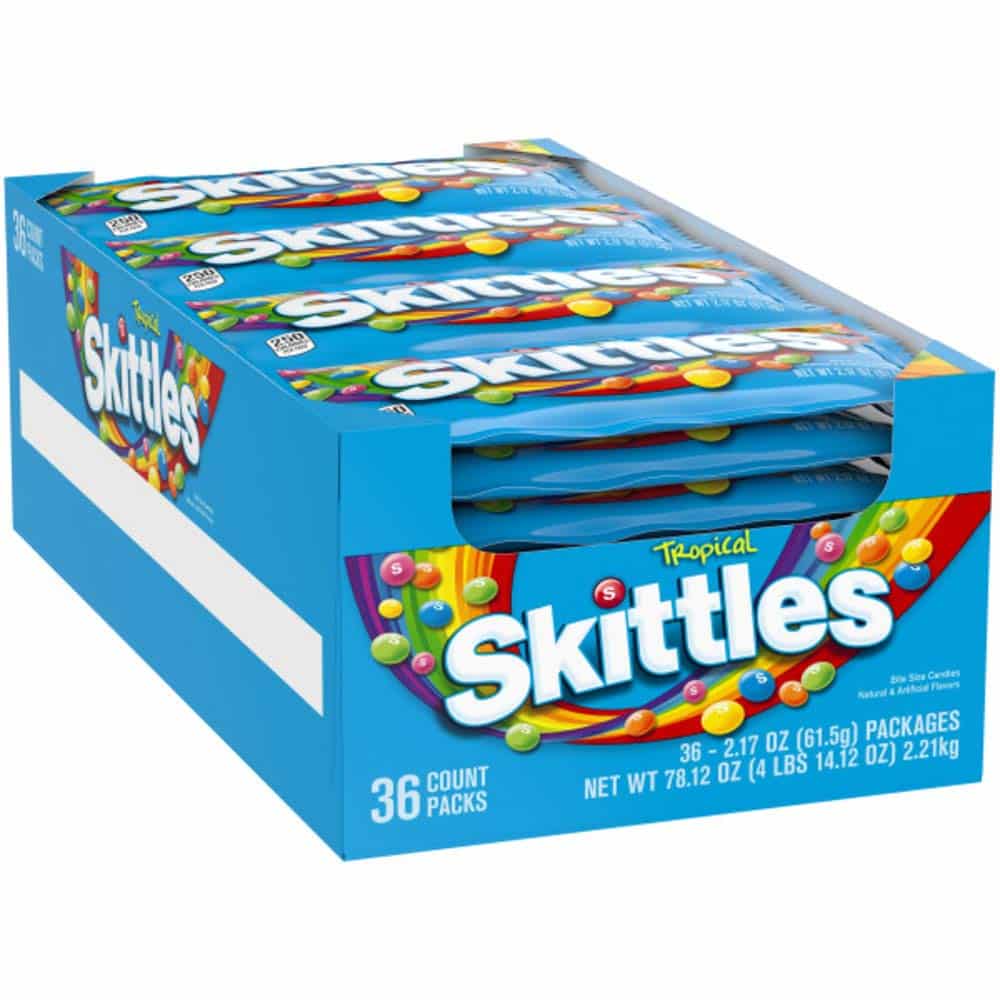
Blue Skittles was actually invented in 1989. Skittles are a fruit-flavored candy that is known for their brightly colored shells and chewy centers. The addition of a blue flavor to the Skittles product line was a very successful decision. Blue Skittles became so popular that in 1994, the company decided to replace the lime flavor with a blue raspberry flavor in the “Wild Berry” variety.
Skittles is very well-liked by kids and adolescents due to its vibrant hues. The sweets were initially packaged in typical red wrapping. However, since the introduction of various candy versions, wrapping has seen a wide variety of colors. The most recent flavor additions are Wild Berry, Sour Skittles, and Tropical.
The letter “S” is written on Skittles. For instance, the flavors of yellow are lemon, green is lime, purple is grape, and so forth. The current candy manufacturer, The Wrigley Company, even started the “Experience the Rainbow” marketing campaign in 1994.
5. Blue Blow Pops
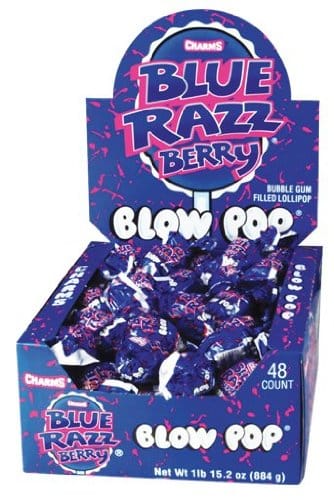
Blue Blow Pops were first introduced by the American candy company, Charms, in the mid-1990s. Blow Pops are a type of lollipop that has a bubble gum center, making them a two-in-one treat. Blow Pops come in a variety of flavors and colors, but the blue raspberry flavor has remained a popular choice among consumers. They are often sold in individual wrappers or bulk bags, making them a convenient and fun treat to enjoy.
Thomas Tate Tidwell Jr. created Charms Blow Pops. The Charms Candy Corporation would eventually spread awareness of this product. The first best-selling item this business had to offer was Charms Blow Candies. Even though they are no longer the business that promotes them, this is currently their best-selling product of all time.
Bottom Line
In conclusion, blue candy has become a popular and recognizable category of sweets, thanks to its bright and distinctive color. Many blue candy manufacturers have introduced blue flavors to their product lines, such as Blue Raspberry Airheads, Blue Sour Patch Kids, Blue Skittles, and Blue Blow Pops. Whether as a standalone treat or as part of an assortment, blue candy is a fun and delicious way to satisfy a sweet tooth.

Nato is a content writer and researcher with a background in psychology. She’s passionate about writing about the candy industry and exploring the cultural significance of sweets and treats. She believes that the stories behind our favorite snacks can reveal a great deal about our values.
Please leave a review or any memories of this snack in the comments below. Thank you!
Click here for a full A-Z list of Snacks and Candy
